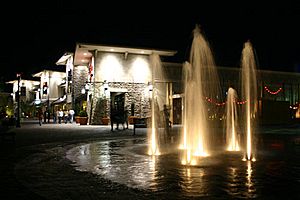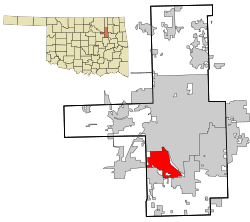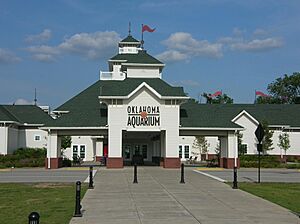Jenks, Oklahoma facts for kids
Quick facts for kids
Jenks, Oklahoma
|
||
|---|---|---|

Riverwalk Crossing on the Arkansas River, Jenks
|
||
|
||

Location within Tulsa County, and the state of Oklahoma
|
||
| Country | United States | |
| State | Oklahoma | |
| County | Tulsa | |
| Area | ||
| • City | 17.95 sq mi (46.49 km2) | |
| • Land | 17.11 sq mi (44.32 km2) | |
| • Water | 0.84 sq mi (2.17 km2) | |
| Elevation | 617 ft (188 m) | |
| Population
(2020)
|
||
| • City | 25,949 | |
| • Density | 1,516.51/sq mi (585.54/km2) | |
| • Metro | 1,034,123 (US: 54th) | |
| Time zone | UTC-6 (Central (CST)) | |
| • Summer (DST) | UTC-5 (CDT) | |
| ZIP code |
74037
|
|
| Area code(s) | 539/918 | |
| FIPS code | 40-37800 | |
| GNIS feature ID | 1094209 | |
Jenks is a city in Tulsa County, Oklahoma, United States, and a suburb of Tulsa, in the northeastern part of the state. It is situated between the Arkansas River and U.S. Route 75. Jenks is one of the fastest-growing cities in Oklahoma. The city's population was 16,924 in the 2010 census, but by 2020, this had grown to 25,949. The Census estimated Jenks' population as 27,553 in 2023.
Contents
History
Jenks began in 1904 as a community site established by the Midland Valley Railroad between Tulsa and Muskogee, alongside the Arkansas River. Though the river could only be utilized by shallow draft steamboats while the water level was up, these two transportation routes proved vital to Jenks' early development.
Jenks was named after William Henry Jenks the owner and director of the Midland Valley Railroad. According to a 1957 article in the Tulsa Tribune, an agent for the townsite company was told by the railroad home office to name a town for the director.
The town was officially platted on July 15, 1905. Also in 1905, a major petroleum discovery was made, further bolstering the economy of the area. The "Glenn Pool" oil well and subsequent oil claims brought many business people to the general area. In 1906, many oil depots (also known as "tank farms") were constructed in Jenks. By the time of statehood, Jenks had 465 inhabitants.
As oil production waned, tank farms were dismantled, and agriculture became once again a major contributor to the Jenks economy. The economy of the area was further improved in the 1920s when many Bulgarian families immigrated to the area to farm. These immigrants established many vegetable farms.
From 1904 through the 1950s, Jenks experienced many floods from the overflow of the Arkansas River and Polecat Creek. In the 1920s and 1930s, floods were severe. During one flood in the late 1920s, the water was so deep that it completely covered every building but the roof of the three-story-high school. Everyone was evacuated except two men and one woman. They had one shotgun, one small boat, food and a tent on top of the school. They guarded the remains of Jenks for several weeks until the water receded. In 1948, the U.S. Army Corps of Engineers built a levee around Jenks, and the community subsequently grew as a result of the increased safety and security. There was another threat of severe flooding in 1986, when severe rainstorms upstream along the Arkansas River forced the Corps of Engineers to release as much as 300,000 cubic feet per second from the Keystone Dam into the river. This caused a mandatory evacuation order in Jenks and several other river communities.
Jenks has served as a river crossing point via several bridges over the past century. In 1910, a single-lane bridge was built and strengthened the economic success of the area. The year 1948 saw the construction of a replacement two-lane bridge, which still stands today and now serves as a pedestrian crossing between the Riverwalk and the South Tulsa River Parks. The original 1910 bridge was destroyed and all that is left are a few columns and pieces of metal that are seen when the water level is low. A four-lane bridge was built in 1996.
The current High School building was built in 1960-61 and has undergone three major additions. The United States Census of 1970 placed the population of the city at 1,990 and there were approximately 1100 students in public school.
In the 1970s, the Tulsa water system was expanded into Jenks. That decade also saw the construction of a nearby Public Service of Oklahoma gas-fired electric power plant. These developments improved the infrastructure of the area and helped the economy.
In the 1980s, Kimberly-Clark built a manufacturing facility that provides many jobs for the area to this day.
Geography
Jenks is located at 36°0′37″N 95°58′47″W / 36.01028°N 95.97972°W (36.010276, -95.979850).
According to the United States Census Bureau, the city has a total area of 17.73 square miles (45.9 km2), of which 17.13 square miles (44.4 km2) is land and 0.6 square miles (1.6 km2) (3.69%) is water.
Demographics
| Historical population | |||
|---|---|---|---|
| Census | Pop. | %± | |
| 1910 | 290 | — | |
| 1920 | 1,508 | 420.0% | |
| 1930 | 1,110 | −26.4% | |
| 1940 | 1,026 | −7.6% | |
| 1950 | 1,037 | 1.1% | |
| 1960 | 1,734 | 67.2% | |
| 1970 | 2,685 | 54.8% | |
| 1980 | 5,876 | 118.8% | |
| 1990 | 7,493 | 27.5% | |
| 2000 | 9,577 | 27.8% | |
| 2010 | 16,924 | 76.7% | |
| 2020 | 25,949 | 53.3% | |
| 2023 (est.) | 27,553 | 62.8% | |
| Sources: 2020 U.S. Decennial Census |
|||
2010 census
As of the 2010 census, there were 16,924 people, 5,954 households, and 4,753 families residing in the city. The population density was 988.1 inhabitants per square mile (381.5/km2). There were 6,395 housing units. The racial makeup of the city was 82.8% White, 2.8% African American, 5.5% Native American, 2.3% Asian, 0.002% Pacific Islander, 1.8% from other races, and 4.8% from two or more races. Hispanic or Latino of any race were 4.8% of the population.
Community and tourism
Popular tourist draws include the Oklahoma Aquarium (the state's only freestanding aquarium) and Jenks’ the Ten downtown blocks is known as The The Ten District has shops including boutiques, restaurants, and the Antiques and Arts District.
Jenks was named the “Antique Capital of Oklahoma” by the former first lady of Oklahoma, Shirley Bellmon, and the many stores that call Main Street home keep that tradition going. Visitors can park and walk all day browsing vintage wares alongside new and repurposed offerings.
Spring days are perfect for enjoying the sunshine and admiring the flower pots full of tulips, provided by the Jenks Garden Club.
A pedestrian bridge links the Jenks riverfront area with the Tulsa Riverparks walking trail on the East side of the river. Another one of Jenks' main attractions is the high school football team, which has won 14 state championships, including six consecutive from 1996 to 2001. The Trojans have sent many players to the collegiate level in the last 15 years, including Rocky Calmus (Oklahoma/Tennessee Titans), Sean Mahan (Notre Dame/Tampa Bay Buccaneers), Jason Lohr (Nebraska), Jason Carter (Oklahoma), Garrett Mills (Tulsa/Minnesota Vikings), Chase Beeler (Stanford), Bryan Pickryl (Texas), Kejuan Jones (Oklahoma), Jay Henry (West Virginia), Phillip Dillard (Nebraska/New York Giants), Corey Callans (Oklahoma), Jake Laptad (Kansas), Cory Dorris (Tulsa), Chris Adkins (Tulsa), Gabe Lynn (Oklahoma), Tramaine Thompson (Kansas State), Trent Martin (Tulsa), Zack Langer (Tulsa), Alex Ross (Oklahoma), Matt Linscott (Tulsa) Steven Parker (Oklahoma/LA Rams/Miami Dolphins), Jordan Smallwood (Oklahoma).
Jenks also is home to numerous antique stores and hosts many street festivals and parades each year, such as the Art on Main (which has an attendance of 12,000).
The Jenks School District is one of the largest in the state and encompasses significant portions of southwest Tulsa, while many of the Jenks schools are located within the city of Tulsa.
On November 22, 2005, President George W. Bush and Commerce Secretary Carlos Gutierrez announced Jenks Public Schools as a recipient of the 2005 Malcolm Baldrige National Quality Award, the nation's highest Presidential honor for quality and organizational performance excellence.
Economy
In 1958, Richard Lloyd Jones Jr. Airport opened for business just outside Jenks. This airport is the official reliever for Tulsa International Airport and is one of the busiest in the state. It serves commercial and private air travel throughout the Tulsa area and has helped stimulate the growth of Jenks' economy.
Jenks is home to the headquarters of many small and large businesses, among which include; Kimberly Clark Corporation, Green Country Energy, Public Service Company, Tulsa Winch, Continental Wire Cloth, and Tedford Insurance. Jenks is also the headquarters of First Oklahoma Bank, which first began construction on its eight-story building in December 2012.
Notable people
The following notable people are known to be from Jenks or to have attended the Jenks Public Schools:
- R. Perry Beaver, head football coach at Jenks High School 1977–1990, principal chief of Muscogee (Creek) Nation 1996–2003
- Jennifer Berry, Miss America 2006
- Jim Bridenstine, former United States Representative for Oklahoma's 1st congressional district and current administrator of National Aeronautics and Space Administration.
- Trey Callaway, screenwriter and television producer
- Rocky Calmus, football player, Butkus Award winner, NFL linebacker
- Brad Carson, former member of U.S. House of Representatives, director of National Energy Policy Institute at University of Tulsa
- Simon Curtis, actor and musician
- Phillip Dillard, NFL linebacker
- Josh Johnson, Major League Baseball pitcher for San Diego Padres
- Tyrel Lacey, professional soccer goalkeeper
- Ben Lamb, 2011 World Series of Poker Player of the Year
- Danielle Laney, bronze medalist in Taekwondo at the 1992 Summer Olympics
- Sean Mahan, NFL center for Tampa Bay Buccaneers
- Garrett Mills, NFL player for Minnesota Vikings
- Brian Nhira, singer, contestant on The Voice
- Tyler Ott, long snapper for the Baltimore Ravens
- Brian Presley, actor
- Ryan Tedder, lead singer of OneRepublic, attended Jenks schools until senior year in high school
- Colonel Theodore S. Westhusing, West Point professor of English and Philosophy
- Jerry Wisne, NFL player for Chicago Bears
See also
 In Spanish: Jenks (Oklahoma) para niños
In Spanish: Jenks (Oklahoma) para niños



